First published c.29 B.C. Penguin, paperback, 2002, translated by Aubrey de Sélincourt, pp 488, c.155,000 words (main text).
Roman historians of Livy’s period apparently valued literary style above historical accuracy, which may be just as well for the general reader because this makes, in the most part, for an excellent read.
This volume is an English translation of Livy’s Latin text, and although it was completed in 1960, it still makes for a highly readable account. English colloquialisms are used in places for which I have no way of knowing how accurately they reflect Livy’s use of language. Neither of the eminent scholars who provide introductions and appendix material comment on this, so I assume that Sélincourt’s translation is still acceptable to scholars.
Livy was trying to write history and not make up the substance of people and events, even if he gives us long speeches by some of the characters which must be fictional but greatly help to warm up the narrative. The Appendix lists five types of source material that were available to Livy to draw on:
- The writing’s of Rome’s Greek neighbours in southern Italy;
- Inscriptions and other documents that survived from early Rome into the late Republic;
- The chronological records of priest and others;
- Archaic institutions that survived into the middle and late Republic;
- The memory and records of Roman families.
The earliest Roman period, that of the kings, is clearly the most fanciful, and the introduction warns us of the similarity between some of these stories and earlier Greek ones. Livy is clearly aware of the dubious nature of these historical accounts. For example, when recounting the story of Romulus and Remus being suckled by a wolf, he says that possibly they were found by a prostitute who was known as The Wolf.
From the expulsion of the kings onwards some documents survived that, at a minimum, list the consuls, two of whom were appointed each year from the nobility. This is perhaps the most tedious aspect of the narrative when, for example, we are told that Spurius Furius (yes, really) and Biggus Dickus (no) were appointed consuls in 482 BC. Sometimes nothing interesting happened in the year except that Rome fought a war against the Volscii and Aequi, again. Occasionally there is a longer section which provides gripping reading. The episode of the Decemvirs and Appius, and that of the wars against the Etruscan Veii and the Gauls are particularly powerful.
Livy is worth reading today, not only as a piece of informative entertainment, but also because it shows how human nature hasn’t changed. The people of Rome two and a half thousand years ago are the same cussed people that inhabit the world today. The rich are out to increase their riches, the poor are out to grab some of it. Sometimes we care about our fellow citizens and sometimes we are out for ourselves. Religion and patriotism are used to influence decisions. Individual personalities can make a difference for good or ill, but are often resented.
The introduction and appendix are well worth reading: shedding light on what is reliable and what not, and placing Livy and his history into the context of his times. There are also a couple of useful maps buried at the end of Livy’s text.
© William John Graham, June 2022

